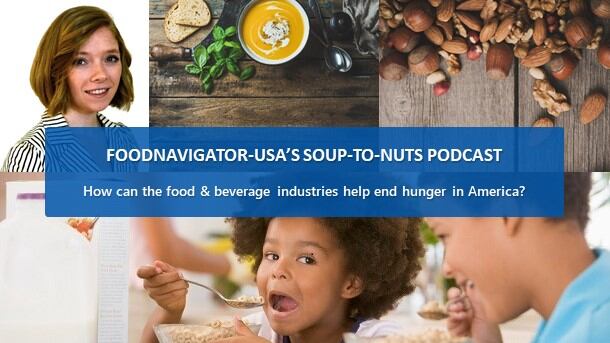Unfortunately, the American dream is not a reality for everyone, and the sobering truth as revealed earlier this week by the Urban Institute’s Well-Being and Basic Needs Survey is that in 2017 nearly 40% of adults in the US said their families had trouble meeting at least one basic need for health care, housing, utilities or – most frequently: food.
Nearly 24% of the almost 7, 600 adults surveyed by the nonpartisan, nonprofit policy group reported that last year there were times that they had unreliable access to enough affordable, nutritious food to sustain themselves and their loved ones.
This problem is not new; and its persistence, even at a time when wages in the US are trending up and unemployment is trending down, suggests the current approaches to easing and eliminating food insecurity aren’t working. So what can or should be done?
In this episode of FoodNavigator-USA’s Soup-To-Nuts podcast, Noreen Springstead, executive director of the non-profit WhyHunger shares a few ideas about how food and beverage industry players – and legislators – can help. But first, she outlines in greater detail what hunger in America looks like, including who it impacts and how. She also talks about the root causes of the problem – some of which are deeply planted in the very industry that is tasked with feeding the nation.
What does hunger in America really look like?
Springstead explains the vast majority of the 42 million people in America who grapple with food insecurity or who don’t always know from where their next meal is coming are not the “stereotypical person living off the government.” Rather, she says, the people who are struggling to stretch their budgets to provide food during the course of any particular month are just as diverse as the country’s overall population.
“Hunger is a reality for one out of eight Americans, 13 million who are children,” she said. “They are either working families, they are children or they are seniors. There certainly are a lot of veterans who are returning from war and unable to make ends meet. They may be homeless. They may be finding a difficult time getting a job. But it is not the stereotypical person living off the government. It is people who are working and relying on food banks, soup kitchens and food pantries to feed themselves and to feed their families.”
The negative consequences of food insecurity are almost as diverse as those who suffer from it, according to Springstead. She explains that the damage caused by hunger is much more than painful pangs in the stomach. It can also lead to chronic health problems or difficulty focusing at work and school, which in turn holds people back from advancing and contributing to society.
Why does hunger persist in America?
While many industry players, non-profits and social and political leaders already are actively fighting hunger in America, the problem persists and is much more pervasive than most people realize.
Springstead says there are several reasons for this – one is a lack of awareness by the broader population and another is even though unemployment is down, wages for many jobs have stagnated while the cost of living has increased.
“Corporate profits are up. Shareholder values are up. But wages have stagnated. People are in low paying jobs,” she said.
While low wages are a problem across the board, Springstead says she is particularly appalled at the degree of the problem within the food system – and calls on industry players to begin addressing food insecurity in America first by evaluating and addressing the extent to which they contribute to a major root cause of the problem.
“Notoriously, food system wages are among the lowest. …Our food bank partners tell us that farm workers are lining up because while they might be picking the food on the American dinner plate, they are not able to make ends meet because they just are not earning enough money and it is hard work. It is incredibly labor intensive work to pick berries, to work in the fields, to maintain a farm. And I would argue that those people really need to be paid fairly so they don’t go hungry,” she said.
It isn’t just farmers though. She notes that people up and down the supply chain either are not making enough per hour or their hours are capped so that they do not qualify for benefits, which means they need help from the government.
What can industry do to help?
Many companies have already started to address this through Fair Trade or direct trade arrangements that seek to pay small farmers and producers around the world a living wage plus enough extra that they can advance their communities.
Others, have corporate giving campaigns that are the life blood to food pantries and food banks – but as Springstead notes, corporations should take a closer look at the quality of what they are donating to ensure it meets the same standards they have for what goes on their dinner plates.
She also suggests they evaluate the environmental impact of their business practices.
Finally, she suggests, industry players – particularly progressive entrepreneurs – can also be incredible assets as members of the board for food banks and pantries or other non-profits tackling food insecurity. That is where, she says, they might have the most immediate impact in changing the dialogue around food insecurity and helping to raise awareness about the problem and the solutions.

